![]()
![]()
![]()
Use LEFT and RIGHT arrow keys to navigate between flashcards;
Use UP and DOWN arrow keys to flip the card;
H to show hint;
A reads text to speech;
36 Cards in this Set
- Front
- Back
- 3rd side (hint)
|
Clinical features of sickle cell anemia
|
Exertional dyspnea, pneumonia resulting in life-threatening acute chest syndrome, and recurrent abdominal and bone pain
|
|
|
|
Most common cause of CF
|
Phenylalanine deletion (delta F508)
|
|
|
|
Explain the meaning of polycistronic
|
Bacterial mRNA is said to be polycistronic, meaning that one mRNA may code for several proteins.
- one example is the lac operon, which codes for proteins necessary for lactose metabolism by E. coli. |
|
|
|
Explain pathogenesis of HbC
What would you see on electrophoresis relative to HbA and HbS? |
missense mutation that causes a substitution of glutamate with lysine int eh beta globin chain (6th position), resulting in creased positive charge of the molecule.
- HbC moves more slowly than both HbA and HbS towards the positive anode |
|
|
|
If the partial pressure at which hemoglobin is 50% saturated (P50) is decreased, what does this mean?
|
Hb has an increased O2 affinity --> causes less O2 to be released into the tissues --> resultant hypoxia produces reflex polycythemia
|
|
|
|
Name sources of oxidative stress for G6PD deficiency
|
Antimalarials, sulfonamides, fava beans
|
|
|
|
Hereditary spherocytosis results from what molecular defect?
|
defects in genes that code for spectrin and ankyrin
|
|
|
|
An infant that is exclusively breast fed may still need what supplementation?
|
Vit D and Vit K
|
|
|
|
Which sugar has the highest rate of metabolism in the glycolytic pathway?
|
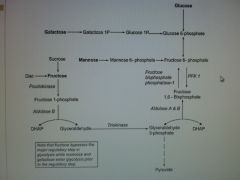
Fructose
|
|
|
|
Describe the process of collagen synthesis
|
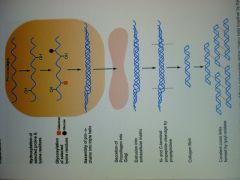
see picture
|
|
|
|
Which prokaryotic DNA pol have proof reading activity and remove mismatched nucleotides via 3' to 5' exonuclease activity?
Which have 5' to 3' exonuclease activity? What is the purpose of this? |
All 3 prokaryotic DNA pol have proofreading activity 3' to 5'
DNA pol I has 5' to 3' exonuclease activity to excise and replace RNA primers and damaged DNA sequences. |
|
|
|
What is the difference between exonucleases and endonucleases?
|
Exonucleases remove nucleotides from the end of a DNA molecule, whereas endonucleases cut DNA at very specific DNA sequences within the molecule.
|
|
|
|
The nucleolus is the site of synthesis of what?
|
The nucleolus is the site of rRNA synthesis from rDNA, the site of ribosomal protein synthesis, nad the site of ribosome formation.
Q: which enzyme produces rRNA? |
RNA pol I
|
|
|
What does RNA pol III transcribe?
|
small RNA molecules such as:
tRNA, the 5S ribosomal RNA, and small nuclear RNA (snRNP) |
|
|
|
Pompe dz results from deficiency in what enzyme?
|
Acid maltase (alpha glucosidase)
|
|
|
|
Which step in the TCA cycle requires thiamine as a cofactor?
- Talk about the results of administration of glucose to thiamine deficient patients |
alpha-KG DH
-Results in Wernicke encephalopathy due to increased thiamine demand --> acute confusion, ophthalmoplegia, and ataxia |
|
|
|
Which enzymes require thiamine in the various metabolic pathways?
|
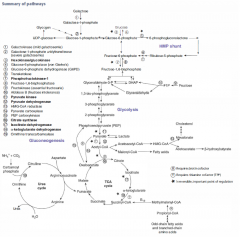
Glycolysis: Pyruvate dehydrogenase
TCA: alpha-KG DH HMP shunt: Transketolase |
|
|
|
List hormone receptors that utilize the G-protein/adenylate cyclase second messenger system.
|
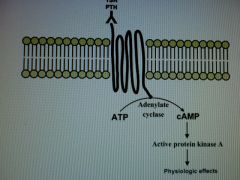
TSH, glucagon, PTH, and beta adrenergic receptors
|
|
|
|
Telomerase: discuss everything about it
|
Telomerase is an RT enzyme (RNA dependent DNA polymerase) that adds TTAGGG repeats to the 3' end of DNA strands at the terminal end of chromosomes, the telomere region.
Normally expressed in stem cells (present in most tissues where they are responsible for replacement of dead cells - epidermal stem cells present in the basal cell layers, bone marrow stem cells) as well as cancer cells. |
|
|
|
Describe four patient populations that are most likely to develop Vit K deficiency:
|
malabsorption syndromes, broad-spectrum antibiotics that destroy intestinal flora, neonates (secondary to their limited hepatic reserves, unestablished intestinal flora, and limited bioavailability of Vit K in breast milk), and those afflicted with generalize liver dz
|
|
|
|
Inhibition of lactate DH in exercising muscles would eventually lead to an inhibition of glycolysis due to intracellular depletion of _______.
|
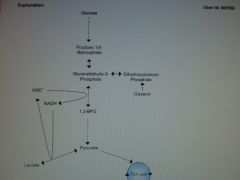
NAD+
Under anaerobic conditions, NADH transfers protons to pyruvate to form lactate and to regenerate NAD+. NAD+ is required to convert glyceraldehyde-3-phosphate to 1,2-bisphosphoglycerate in glycolysis. |
|
|
|
Which amino acid becomes essential in patients with homocystinuria? What is the defective enzyme in this case?
|

Cysteine
Defective enzyme is cystathione synthetase |

|
|
|
Impaired formation of N-acetylglutamate is the cause of a child's increased blood ammonium level.
Which reaction is most likely impaired in this patient? |
CPS I
N-acetylglutamate is an essential activator of CPS I (low yield?) |
|
|
|
Explain the characteristics of tRNA
|
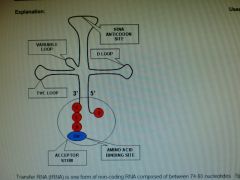
1) small, noncoding form of RNA that contains unusual nucleosides such as pseudouridine and thymidine.
2) has a CCA sequence at its 3' end that is used as a recognition sequence by proteins, and that the 3' terminal hydroxyl group of the CCA tail is used as the binding site for the AA. |
|
|
|
What happens to a protein that undergoes a splice site mutation?
|
Frequently result in production of larger proteins with altered function but preserved immune reactivity.
|
|
|
|
2 major functions of HMP shunt
|
1) production of NADPH as a reducing equivalent
2) synthesis of ribose 5-phosphate for nucleotide synthesis |
|
|
|
Afr. American pt with malaise and dark urine. Recent UTI. Anemia is evident on the CBC and erythrocyte fragments are seen on peripheral smear.
What does pt most likely have? |
G6PD deficiency
NADPH is necessary to keep glutathione reduced, which in turn detoxes free radicals and peroxides. Decrased NADPH in RBCs leads to hemolytic anemia due to poor RBC defense against oxidizing agents. Infection can also precipitate hemolysis. X-linked recessive; more prevalent among blacks; increase malarial resistance |
|
|
|
Where would you find glucokinase?
|
Liver and beta cells of pancreas
|
|
|
|
What might you find on autopsy of someone who died with chronic thiamine deficiency (ie homeless alcoholic)?
How would you be able to diagnose this? |
Foci of hemorrhage and necrosis in the mamillary bodies and periaqueductal gray matter
- look at enzyme activity of the enzymes that require thiamine: pyruvate DH, transketolase, alpha-KG DH |
|
|
|
Marfan vs Ehlers-Danlos differences in clinical presentation
|
Marfan: fibrillin gene mutation; connective tissue disorder affecting skeleton, heart, and eyes; Sx: tall with long extremities, pectus excavatum, hyperextensive joints, arachnodactyly, cystic medial necrosis of aorts (dissecting aneurysms), floppy mitral
Ehlers-Danlos: Type 3 collagen disorder; Hyperextensible skin, tendency to bleed, hypermobile joints, may have berry aneurysms and organ rupture bonus: name some of the mutations leading to EDS phenotypes |

- deficiencies in lysyl-hydrolase and pro-collagen peptidase enzymes responsible for collagen synthesis
|
|
|
For which metabolic reactions is riboflavin (vit b2) used?
|
Dehydrogenase reactions involving FMN and FAD
|
|
|
|
Where is biotin used?
|
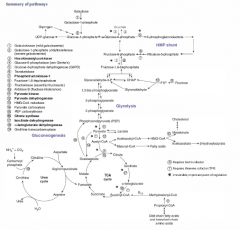
Cofactor for all four carboxylase enzymes: pyruvate carboxylase, acetyl CoA carboxylase, propionyl CoA carboxylase, and 3-methylcrotonyl-CoA-carboxylase
|

|
|
|
OAA forms aspartate while reacting with glutamate. Which vitamin most likely participates in this reaction?
|
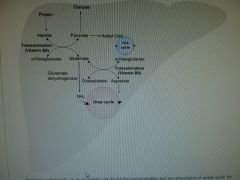
Transamination reactions typically occur between an amino acid and an alpha keto acid. The amino group from the AA is transferred to the alpha keto acid, and the alpha keto acid in turn becomes an AA.
Pyridoxal phosphate (vit B6) serves as a cofactor in AA transamination and in decarboxylation reactions. |
|
|
|
Describe the process of conjugation of bilirubin starting from the RBC to the feces/urine
|

|
|
|
|
Signaling pathways of endocrine hormones:
|
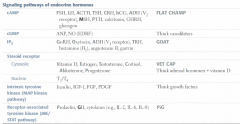
|
|
|
|
Explain the clinical manifestations of porphyria cutanea tarda and describe the pathogenesis:
|

see image
|
|

